| Columns Retired Columns & Blogs |
Acarian Alón Li'l Rascal Mk.II loudspeaker Measurements
Sidebar 3: Measurements
The Alón L'il Rascal Mk.II's voltage sensitivity was very slightly higher than specified, at 89dB(B)/2.83V/m, which is also 2dB above the average I found in my 1999 articles on speaker measurements. Its plot of impedance magnitude and phase (fig.1) revealed it to be an easy load for the partnering amplifier to drive, its impedance dropping below 8 ohms only in the lower midrange. Both sensitivity and impedance values indicate that the Rascal would be a good match for the inexpensive amplifiers with which it is likely to be used.
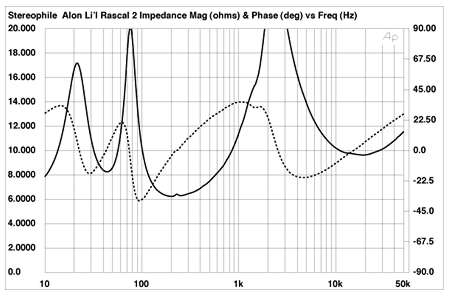
Fig.1 Alón Li'l Rascal Mk.II, electrical impedance (solid) and phase (dashed). (2 ohms/vertical div.)
However, a glitch in the impedance traces at 230Hz implies the existence of a cabinet resonance of some kind at this frequency. Fig.2, a cumulative spectral-decay plot calculated from the output of an accelerometer fastened to the center of the speaker's side wall, shows that not only does a very strong resonance exist at this frequency, but so does an even stronger one at 360Hz. I could detect the higher-frequency resonance only on the sidewall, the lower-frequency one on every surface. I'm puzzled that BJR was not bothered by any lower-midrange congestion that could result from these resonant modes. They were very audible when I listened to the cabinet-wall output with a stethoscope.
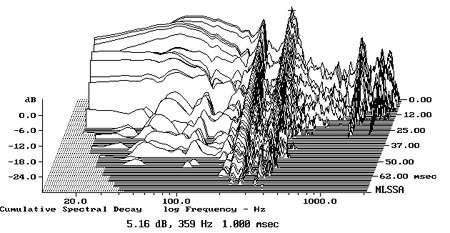
Fig.2 Alón Li'l Rascal Mk.II, cumulative spectral-decay plot calculated from the output of an accelerometer fastened to the cabinet's side panel. (MLS driving voltage to speaker, 7.55V; measurement bandwidth, 2kHz.)
The saddle at 44Hz in the impedance-magnitude trace suggests that this is the tuning frequency of the 2"-diameter reflex port on the front panel. However, the corresponding minimum in the woofer's response (fig.3, red trace) occurs a little lower in frequency, at 40Hz, while the maximum in the port's output (blue) is higher, between 60Hz and 80Hz. However, the complex sum of the two nearfield responses (black) is -6dB at 44Hz, which is just above the lowest note of the four-string bass guitar and double-bass. Note that all of these low-frequency traces are affected by the nearfield measurement technique, which assumes a half-space acoustic environment. This boosts the level of the traces by 3dB below 200Hz or so, which means the Li'l Rascal's absolute LF extension will be a little more restricted. However, it is fair to note that BJR felt the speaker offered good in-room extension for its size.
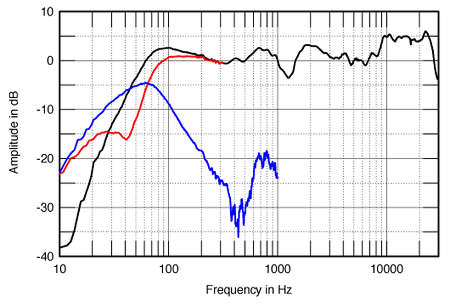
Fig.3 Alón Li'l Rascal Mk.II, anechoic response on tweeter axis at 50", averaged across 30 degrees horizontal window and corrected for microphone response, with the nearfield responses of the woofer (red) and port (blue) and their complex sum (black) below 300Hz, 1kHz, and 300Hz, respectively.
Higher in frequency, there is a small peak in the port's output between 600Hz and 800Hz, which coincides with a small peak in the Rascal's farfield response. Note the notch just above 1kHz, which coincides in frequency with a discontinuity in the impedance traces, with then another small peak. These, along with the shelved-down lower mids, might contribute to BJR's finding the speaker to have a "crisp presentation." The top audio octave is boosted by 5dB, which, all things being equal, correlates with BJR's finding the Li'l Rascal to exaggerate vocal sibilance.
Of course, all things are never equal. The Li'l Rascal's horizontal dispersion plots (fig.4, actual responses; fig.5, differences in response) show that the tweeter's output falls off rapidly above 11kHz at more than 20 degrees to the speaker's sides. In larger rooms, this will tend to offset the Rascal's shelved-up on-axis response, but the region between 8kHz and 11kHz will still be tipped up in absolute terms.
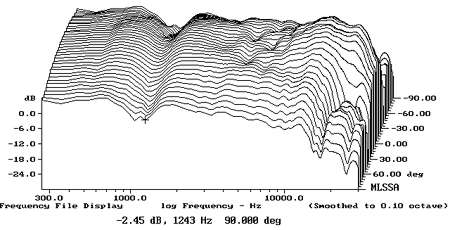
Fig.4 Alón Li'l Rascal Mk.II, lateral response family at 50" on tweeter axis, from back to front: responses 90 degrees-5 degrees off-axis, reference response, responses 5 degrees-90 degrees off-axis.
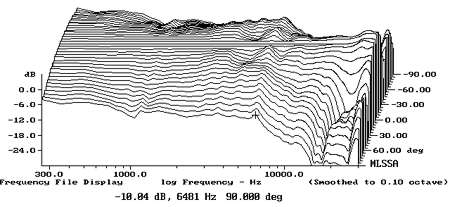
Fig.5 Alón Li'l Rascal Mk.II, lateral response family at 50", normalized to response on tweeter axis, from back to front: differences in response 90 degrees-5 degrees off-axis, reference response, differences in response 5 degrees-90 degrees off-axis.
Note that in fig.4, the suckout between 1kHz and 2kHz persists at all off-axis angles. A week or so after I had measured the speaker and shipped it back, I received an e-mail from Alón's Carl Marchisotto saying that the Rascal was intended to be listened to, not on the tweeter axis, but halfway between the tweeter and woofer. The speaker's vertical-dispersion plot (fig.6) does indicate that the suckout begins to fill in 5 degrees below the tweeter axis. However, it doesn't do so completely until the listening axis is actually below the woofer. It deepens even further above the tweeter; the Li'l Rascal should be used on high stands. The 24" stands used by BJR imply a low listening seat that places the listener's ears around 32" from the floor, unless the speaker is tilted back slightly.
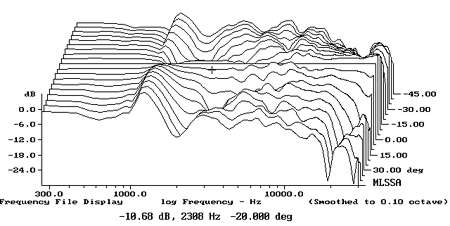
Fig.6 Alón Li'l Rascal Mk.II, vertical response family at 50", normalized to response on tweeter axis, from back to front: differences in response 45 degrees-5 degrees above axis, reference response, differences in response 5 degrees-45 degrees below axis.
In the time domain, the step response on the tweeter axis (fig.7) reveals the HF unit to be connected in inverted acoustic polarity, its positive-going overshoot almost coinciding with the woofer's positive-going step. The small glitch just past the timeline in what would have otherwise been a smooth curve indicates that Carl Marchisotto was correct: the best integration between the two units will occur just below the tweeter axis. But there is also a strong reflection apparent about 450µs after the main arrival. This is just the right delay to give the interference suckout noted in the frequency-domain measurements.
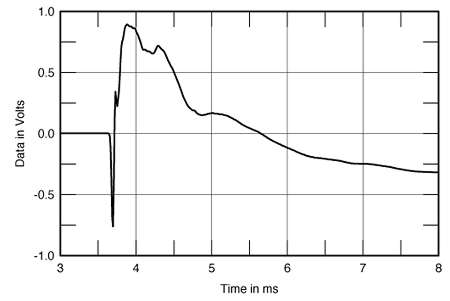
Fig.7 Alón Li'l Rascal Mk.II, step response on tweeter axis at 50" (5ms time window, 30kHz bandwidth).
Finally, the Li'l Rascal Mk.II's cumulative spectral-decay plot (fig.8) is very clean throughout the tweeter region. The on-axis notch above 1kHz is associated with delayed energy, which ties in with the strong reflection seen in fig.7. Overall, the Alón's measured performance is about average—not bad, considering its low price.—John Atkinson
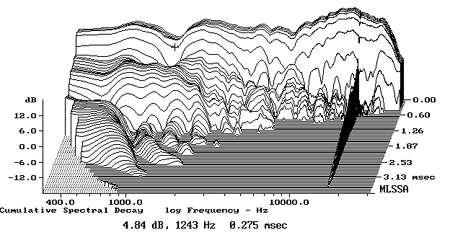
Fig.8 Alón Li'l Rascal Mk.II, cumulative spectral-decay plot at 50" (0.15ms risetime).
Measurements Postscript
When I received the Li'l Rascal samples back from Bob Reina, now sporting thin felt rings around their tweeters, I didn't expect to find much measurable difference. I was wrong, however. The blue trace in fig.9 shows the speaker's quasi-anechoic response above 300Hz without the felt ring (it's the same curve shown in fig.3). The red trace is the same sample but now with the felt ring; the black trace (offset by 5dB for clarity) shows the difference between the two responses. (Ignore the ripples below 2kHz in the difference plot, which are due to the slightly but unavoidably different FFT windows used for the two sets of measurements.)
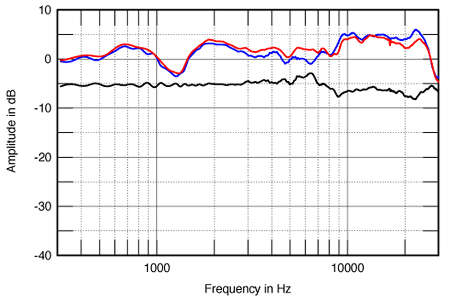
Fig.9 Alón Li'l Rascal Mk.II, anechoic response on tweeter axis at 50", averaged across 30 degrees horizontal window and corrected for microphone response, without (blue) and with tweeter diffraction ring (red), and the difference between them (black).
Despite its thinness, the felt ring has improved the speaker's treble balance, in that it is smoother, just as Carl Marchisotto claims. While the top octave is still "hot" in absolute terms, the region above 7kHz now has a little less energy, while the mid-treble has been reinforced by 1-2dB. Both of these correlate with BJR's finding that the speaker now had a more satisfying balance.
It is important to note that the rings are way too thin and of the wrong texture to provide any damping action. What they do is to change the speaker's dispersion, pushing more or less energy off-axis to smoothen the on-axis behavior. This can be seen in fig,10, which shows the revised speaker's lateral radiation pattern. Comparing this graph with fig.5, it can be seen that the overall dispersion with the tweeter ring is smoother overall, wider above 7kHz, and no longer has the off-axis "horns" at 6.5kHz.
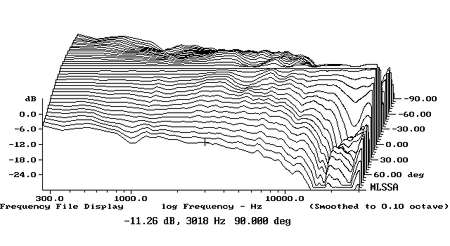
Fig.10 Alón Li'l Rascal Mk.II with tweeter diffraction ring, lateral response family at 50", normalized to response on tweeter axis, from back to front: differences in response 90 degrees-5 degrees off-axis, reference response, differences in response 5 degrees-90 degrees off-axis.
I echo Bob Reina's recommendation, that owners of early Rascals upgrade their speakers with the tweeter rings.—John Atkinson
- Log in or register to post comments




































